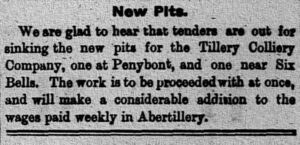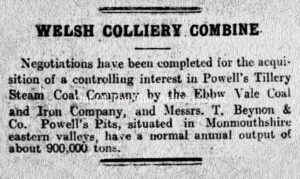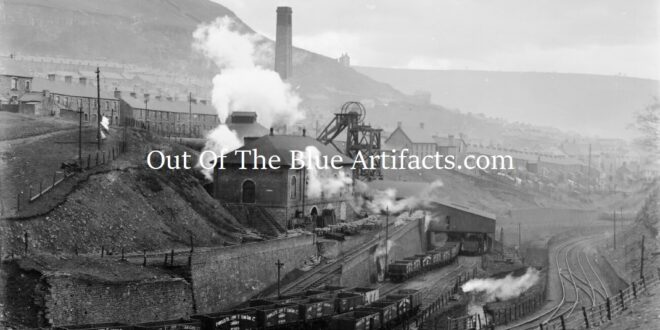The Gray Colliery – A Brief History.
Powell’s Tillery Colliery Company.
 The Sinking of the Gray and the Vivian Collieries 1889.
The Sinking of the Gray and the Vivian Collieries 1889.
The Vivian Colliery at Six Bells and the Gray Colliery at Abertillery were sunk at the same time under the directorship of the owners the Powell’s Tillery Colliery Company. Tenders were invited for the sinking in January 1889.
The Cutting of the Sod Ceremony.
On Tuesday 19th of February 1889, the ceremony of “Cutting the Sod” took place at both collieries. At 10.00am a special train with several spacious saloon carriages was laid on for the dignitaries which travelled from Cardiff to Newport and then shunted through Newport up the western valley to Abertillery Railway Station. The dignitaries then made their way to town and gathered at the site of the proposed Gray Colliery. The group chosen to cut the sod of the new collieries were led by Mr John Hacquoil the Cardiff agent for the Powell’s Tillery Company on behalf of Mr T. W. Powell who regretted not being there as he was in Australia, also present were Mr Dawson the company manager and Mr E. C. P. Hull a director of the company who accompanied the ladies in the party.
The Placing of the Gold Nuggets.
A brief address was given by Mr Dawson and the honour of cutting the first sod was given to Miss Hacquoil, Mr Hacquoil, Miss Alice Hacquoil, Miss Dawson, Mr Dawson and Mr Hull cut the others on that site. The group later submitted themselves and posed for many photographs. They then proceeded to the Vivian Colliery at Six Bells where they went through the same procedure. The cutting of that sod on the marked-out area was given to the ladies. Afterwards the Rev Mr Walters added a few words of congratulations and formally named the two collieries the “The Vivian and the Gray”. During the cutting of the sod ceremony, pieces of gold was placed in the holes from where the sod came out, this was traditional and done as a gift to the pit sinking crews.
The Sinking Contractors.
The sinking of the collieries was in the capable hands of Mr F. Coulson (Durham) and the head sinker Mr Joseph Briggs.
The party went back into town to the Tillery Reading Rooms, Abertillery for lunch, then made their way back to Cardiff.
Mr John Burgess.
On Saturday 16th of May 1891, the Vivian and Gray Colliery sinkers held a testimonial in the Railway Inn for Mr John Burgess, the organiser of the fund for the widows and children of the sinkers who had lost their lives in the tragedy of Dec 1890 during the sinking of the Vivian Pit. The sinkers who presented the gift to Mr John Burgess were – Joseph Briggs the head sinker, Johnson Briggs, Thomas Carney, Matthew Clarke and James Powell. (More information to come)
The Early Workforce.
Below are some of the men who were listed as working at the Gray Colliery in the early years.
Mr Andrew Hailstones.
Mr Andrew Hailstones from Scotland came to Abertillery to help sink the Gray Colliery, he stayed in the valley and worked as the colliery winderman.
Mr William Exton was the first pit ostler. In 1935 Mr William Exton lived at Newdale, Royal Lane, Blaenau Gwent.
Mr William James Bird was the shoeing smith.
Mr Albert Edwin Holbrook.
Mr Albert Edwin Holbrook was from Somerset, in his youth became an engineer and in the 1870’s was engaged on the building of the Severn Railway Bridge in which he did all his work from a diving-bell. He later worked on erecting Cleopatra’s Needle on the Thames Embankment. At one time a pleasure steamer sank on the River Thames and he was the diver employed on the salvage work.
In the late 1870’s early 1880’s, Mr Holbrook then went on to work on driving the Severn Tunnel. In later years he showed great knowledge in the South Wales Coalfield and became one of the top pit contractors in the Western Valley’s. Mr Albert Edwin Holbrook lived in Cromwell Street, Abertillery and was engaged in sinking operations in many of the local pits, he deepened the Rose Heyworth Colliery to the deeper seams and drove the connection tunnel from the Gray Colliery to the Vivian Colliery for ventilation purposes.
Mr Holbrook was a founding member – Membership number 57 of the Liberal and Labour Club, Abertillery.
The Death of Mr Albert Edwin Holbrook.
Mr Holbrook died in 1934 at the age of 78, he lived at 38 Victoria Street, Blaenau Gwent.
Master Lewis John.
On Friday 18th of March 1955, the South Wales Gazette published a story on Mr Lewis John of 71 Princess Street, Abertillery. It was stated that Mr Lewis John was the first boy to work down the Gray Colliery, Abertillery. Mr John was born in 1884.
Coal Production at the Gray Colliery.
After the sinking of the Gray Colliery began in 1889 the actual opening took some time, slightly delayed, the first coal was wound in the early 1890’s.
Powell’s Tillery Company.
From the time of its sinking and through the early part of the 1900’s the colliery was owned by the Powell’s Tillery Colliery Company along with the Vivian and Penybont Collieries. A drivage (underground tunnel) was driven from the Vivian Colliery to the Gray Colliery then onto and into the Penybont Tillery Colliery for ventilation purposes. The Gray Colliery became the up-cast shaft for the three Powell’s Tillery combine collieries.
The Powell’s Tillery Steam Coal Company.
At some point in time, around the turn of the century the Powell’s Tillery Colliery Company was renamed as the Powell’s Tillery Steam Coal Company, though the former name was used in news reports until the take over by the Ebbw Vale Steel, Iron and Coal Company.
Ebbw Vale Steel Iron and Coal Co Ltd & T. Beynon and Co Ltd.
In May 1916, negotiations began to acquire the collieries belonging to the Powell’s Tillery Steam Coal Co Ltd by the Ebbw Vale Steel, Iron and Coal Co Ltd & T. Beynon and Co Ltd.
The new directors consisted of Mr J. W. Beynon the head of T. Beynon and Co and the director of the Ebbw Vale Company; Mr Frederick Mills the managing director; Sir Henry Mather Jackson-Bart and Major John Charters Kirk.
The Powell’s Tillery Steam Coal Company Ltd had a share capital of £144,006 and a debenture issue of £65,200, The collieries output was about 900,000 tons annually, total value was over half a million sterling. The Powell’s Tillery Company directors were – Col H. A. Powell; Messrs E. Heseltine; William Newall; W. J. Roch; and William Stewart (Managing Director); would retire. The Ebbw Vale Co were to take over the management of these collieries.
 The Ebbw Vale Company Takeover.
The Ebbw Vale Company Takeover.
On Friday 30th of June 1916, the collieries belonging to the Powell’s Tillery Steam Coal Co Ltd were finally acquired by the Ebbw Vale Steel, Iron and Coal Co Ltd & T. Beynon and Co Ltd (as seen right). The new directors consisted of Mr J. W. Beynon the head of T. Beynon and Co and the director of the Ebbw Vale Company; Mr Frederick Mills (Managing Director); Sir Henry Mather Jackson-Bart; and Major John Charters Kirk.
The New Ventilation Fan.
In 1923 a new ventilation fan was installed at the Gray Colliery to improve the ventilation.
The New Drift.
In August 1929 a new drift was driven from the Gray Colliery to aid in ventilation.
Messrs Partridge Jones and John Paton Ltd.
In July 1937 it was reported that the collieries of the Ebbw Vale Steel, Iron and Coal Co Ltd had recently been taken over by the Messrs Partridge Jones and John Paton Ltd.
Throughout its short history the Gray Colliery, Abertillery was closed and re-opened many times, partly due to lack of trade and other problems such as losing the coal seams and other difficulties. The colliery stopped producing coal sometime in the 1930’s and became a mines training facility. The colliery headgear remained long after it closed and later the whole area was covered over with waste during the valley landfill scheme in the early 1970’s.
The Later Years.
The Abertillery Comprehensive School now occupies the colliery site and the old shaft is directly beneath the school’s netball and tennis courts.
(More information to come)
 Out Of The Blue Artifacts A Library of a lifetime of collecting
Out Of The Blue Artifacts A Library of a lifetime of collecting
